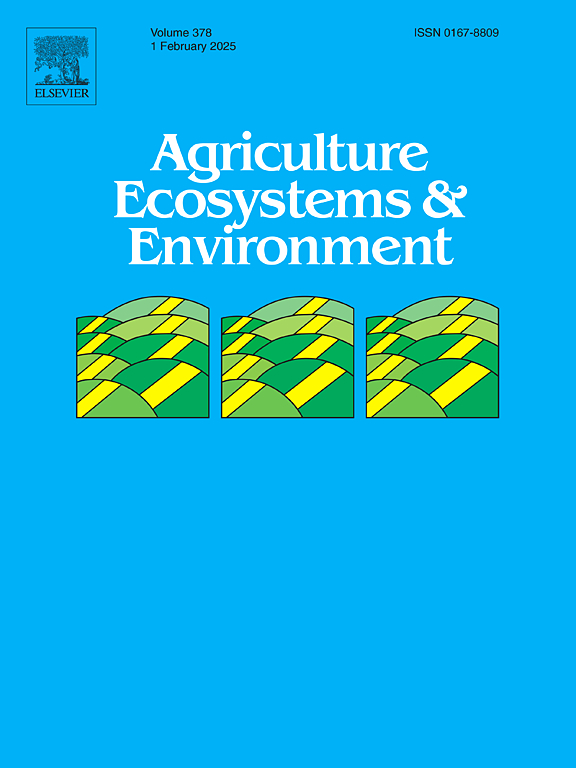Grassland duration affects soil organic carbon pools only in the topsoil and has limited effects on microbial metabolism
IF 6.4
1区 农林科学
Q1 AGRICULTURE, MULTIDISCIPLINARY
引用次数: 0
Abstract
The sustainability of agricultural production relies on the regeneration of soil organic carbon (SOC), both in particulate organic carbon (POC) and mineral-associated (MAOC) forms. Incorporating grass into cropping systems has often been claimed beneficial for increasing SOC. However, the impact of grass duration -ranging from months to years or decades-, on SOC pools and microbial metabolism throughout the soil profile remains unclear. In this study, the effects of three grass-based forage systems on SOC stocks and their distribution across POC and MAOC fractions, after 29 years in a long-term field experiment in NW Italy was investigated. The grass-based forage systems included: permanent grassland; four years of temporary (ley) grassland in rotation to three years of maize monoculture; and an annual double cropping with eight months of grass in rotation to four months of maize. We also evaluated the relationship between these forage systems and soil microbial traits. Our findings showed that SOC, free POC, occluded POC, and MAOC stocks were significantly lower in temporary grassland and double cropping forage systems compared to permanent grassland, but these effects were confined to the topsoil. SOC stocks and their distribution across fractions were similar in temporary grassland and double cropping grass-based forage systems. No differences related to the grass duration in the forage systems were detectable in the subsoil. Microbial carbon use efficiency was poorly affected by the grass duration, but showed a significant depth gradient, decreasing in the topsoil and increasing in the subsoil, primarily driven by changes in pH and soil C:N ratios. Similarly, C-degrading enzymatic activities were influenced more by soil depth than by the grass-based forage system. Overall, our results highlighted the critical role of permanent grassland in promoting SOC accumulation. However, TG as well as DC also played an important role in mitigating SOC depletion.
草地持续时间只影响表层土壤有机碳库,对微生物代谢的影响有限
农业生产的可持续性依赖于土壤有机碳(SOC)的再生,包括颗粒有机碳(POC)和矿物相关碳(MAOC)形式。在种植系统中加入牧草通常被认为有利于增加有机碳。然而,草的持续时间(从几个月到几年或几十年)对整个土壤剖面的有机碳库和微生物代谢的影响尚不清楚。在意大利西北部进行了为期29年的长期田间试验,研究了3种草基饲料系统对有机碳储量及其在POC和MAOC组分中的分布的影响。草料系统包括:永久草地;4年临时(ley)草地轮作至3年玉米单一栽培;一年两季,8个月草轮作4个月玉米轮作。我们还评估了这些牧草系统与土壤微生物性状之间的关系。研究结果表明,与永久草地相比,临时草地和双作草料系统土壤有机碳、游离POC、封闭POC和MAOC储量显著降低,但这些影响仅限于表层土壤。临时草地和复作草基牧草系统中有机碳储量及其各组分分布相似。在底土中没有检测到与饲料系统中草期相关的差异。微生物碳利用效率受草期影响不大,但表现出明显的深度梯度,表层土壤碳利用效率下降,底土碳利用效率上升,主要受pH和土壤碳氮比变化的驱动。同样,土壤深度对c -降解酶活性的影响比对草料系统的影响更大。总体而言,我们的研究结果突出了永久草地在促进有机碳积累方面的关键作用。然而,TG和DC在减轻有机碳损耗方面也发挥了重要作用。
本文章由计算机程序翻译,如有差异,请以英文原文为准。
求助全文
约1分钟内获得全文
求助全文
来源期刊

Agriculture, Ecosystems & Environment
环境科学-环境科学
CiteScore
11.70
自引率
9.10%
发文量
392
审稿时长
26 days
期刊介绍:
Agriculture, Ecosystems and Environment publishes scientific articles dealing with the interface between agroecosystems and the natural environment, specifically how agriculture influences the environment and how changes in that environment impact agroecosystems. Preference is given to papers from experimental and observational research at the field, system or landscape level, from studies that enhance our understanding of processes using data-based biophysical modelling, and papers that bridge scientific disciplines and integrate knowledge. All papers should be placed in an international or wide comparative context.
 求助内容:
求助内容: 应助结果提醒方式:
应助结果提醒方式:


